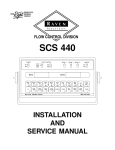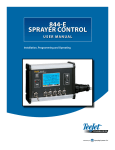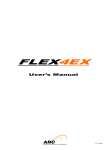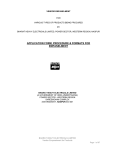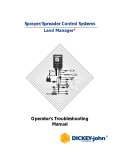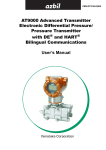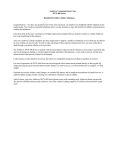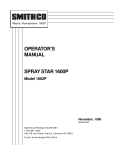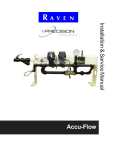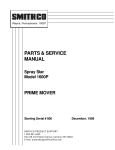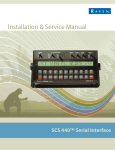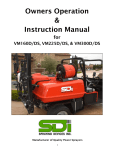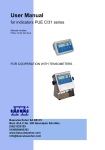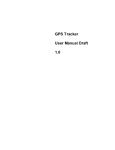Download to Raven Warranty Manual
Transcript
SCS 330
INSTALLATION
AND
SERVICE MANUAL
N O T I C E
The use of the suspension type fertilizers and lime slurries will
significantly reduce the life of the plastic parts in the Flow
Meter and motorized Control Valve. Check the rotor and inlet hub
assembly in the Flow Meter frequently for worn parts. Excessive
wear can affect accuracy.
Do not attempt to modify or lengthen any of the three-wire Speed
Sensor or Flow Meter cables. Extension cables are available from
your Dealer.
Manual Rev. E, SCS 330,
6-98 #016-0159-524
016-0159-524
6/98
TABLE OF CONTENTS
SYMBOL DEFINITION .............................................................................................................................................. 2
INTRODUCTION ....................................................................................................................................................... 3
INSTALLATION ......................................................................................................................................................... 4
1.
2.
3.
4.
MOUNTING
MOUNTING
MOUNTING
MOUNTING
THE
THE
THE
THE
RAVEN RADAR SPEED SENSOR ............................. 4
FLOW METER ........................................... 5
CONTROL VALVE ........................................ 5
CONSOLE AND CABLING .................................. 6
BATTERY CONNECTIONS ...................................................................................................................................... 7
CONSOLE FEATURES ............................................................................................................................................ 8
CONSOLE CALIBRATION ....................................................................................................................................... 9
1.
2.
3.
4.
5.
CALCULATING
CALCULATING
CALCULATING
CALCULATING
CALCULATING
"BOOM CAL" ............................................ 9
"SPEED CAL" .......................................... 10
"METER CAL" .......................................... 11
"VALVE CAL" .......................................... 11
"RATE CAL" ........................................... 12
CONSOLE PROGRAMMING ................................................................................................................................. 13
1. INITIAL CONSOLE PROGRAMMING ...................................... 14
2. OTHER DISPLAY FEATURES ........................................... 16
3. SELF TEST FEATURE ................................................ 17
4. ALARM MENU ....................................................... 17
5. OFF TARGET ALARM ................................................. 17
6. AUTOMATIC RATE +/- ............................................... 18
7. LOW LIMIT FLOW SET POINT AND LOW LIMIT ALARM .................... 18
8. DISPLAY SMOOTHING ................................................ 18
9. "VALVE CAL" ...................................................... 19
10. CONTROL VALVE DELAY ............................................. 19
11. SEQUENCE TO ACTIVATE DATA-LOCK .................................. 19
12. SEQUENCE TO CHANGE DATA-LOCK .................................... 19
13. ENTER MODE SEQUENCE WITH ACTIVATED DATA-LOCK ................... 20
INITIAL SYSTEM SET-UP ...................................................................................................................................... 20
INITIAL SYSTEM FIELD TEST ............................................................................................................................... 21
PREVENTIVE MAINTENANCE .............................................................................................................................. 21
APPENDIXES
1.
2.
3.
4.
5.
6.
7.
8.
9.
WHEEL DRIVE SPEED SENSOR INSTALLATION AND CALIBRATION ....................................................... 22
SPEEDOMETER DRIVE SPEED SENSOR INSTALLATION AND CALIBRATION ........................................ 25
ALTERNATE BY-PASS LINE PLUMBING SYSTEM ......................................................................................... 27
PROCEDURE TO TEST SPEED SENSOR EXTENSION CABLES................................................................. 29
PROCEDURE TO TEST FLOW METER CABLES ........................................................................................... 30
FLOW METER MAINTENANCE AND ADJUSTMENT PROCEDURE ............................................................. 31
PROCEDURE TO RE-CALIBRATE FLOW METER ......................................................................................... 32
REMOTE SWITCH OPTION .............................................................................................................................. 33
HIDDEN FEATURES .......................................................................................................................................... 34
REPLACEMENT PARTS SHEETS
1
SYMBOL DEFINITION
GPM
lit/min
dl/min
PSI
kPa
GPA
lit/ha
ml/ha
GPK
mm
cm
dm
m
MPH
km
km/h
US
SI
TU
[]
{}
- Gallons per minute
- Liters per minute
- Deciliter per minute
- Pounds per square inch
- Kilopascal
- Gallon per acre
- Liter per hectare
- Milliliter per hectare
- Gallons per 1,000 sq. ft.
- Millimeters
- Centimeters
- Decimeters
- Meter
- Miles per hour
- Kilometers
- Kilometers per hour
- Volume per ACRE
- Volume per HECTARE
- Volume per 1,000 sq. ft.
- Metric numbers
- 1,000 sq. ft. numbers
METER CAL CONVERSIONS
To convert the METER CAL number simply divide the original number (number printed on
Flow Meter label) by the desired conversion factor.
FOR EXAMPLE:
Original METER CAL No. = METER CAL No. for displays in Fluid Ounces
128
Original METER CAL No. = METER CAL No. for displays in Liters
3.785
Original METER CAL No. = METER CAL No. for displays in Pounds
Weight of one gallon
LIQUID CONVERSIONS
U.S. Gallons x 128 = Fluid Ounces
U.S. Gallons x 3.785 = Liters
U.S. Gallons x 0.83267 = Imperial Gallons
U.S. Gallons x 8.34 = Pounds (Water)
LENGTH
1 millimeter (mm) = 0.039 inch
1 centimeter (cm) = 0.393 inch
1 meter (m) = 3.281 feet
1 kilometer (km) = 0.621 mile
1 inch = 25.4 millimeters; 2.54 centimeters
1 mile = 1.609 kilometers
PRESSURE
1 psi = 6.89 kPa
AREA
1 square meter = 10.764 square feet
1 hectare (ha) = 2.471 acres; 10,000 square meters
1 acre = 0.405 hectare; 43,560 square feet
1 square mile = 640 acres; 258.9 hectares
2
INTRODUCTION
The Raven SCS 330 (SPRAYER CONTROL SYSTEM) is designed to improve the uniformity of spray
applications automatically. Its performance relies on the installation and preventive
maintenance of the complete sprayer. It is important that this Installation and Service
Manual be reviewed thoroughly before operating the system. This Manual provides a simple
step-by-step procedure for installing and operating.
The SCS 330 consists of a computer based Control Console, a Speed Sensor, a turbine type
Flow Meter, and a motorized Control Valve. The Console mounts directly in the cab of
the vehicle for easy operator use. The Raven Radar Speed Sensor is mounted on the vehicle
or on the sprayer implement (Speedometer Drive Speed Sensors and Wheel Drive Speed
Sensors are also available). The motorized Control Valve and Flow Meter mount directly
to the framework of the sprayer.
Appropriate cabling is furnished for field
installation.
The operator sets the target rate (volume per area) to be sprayed and the SCS 330
automatically maintains the flow regardless of vehicle speed or gear selection (within
range of selected spray nozzles). A manual override switch allows the operator to
manually control flow for system check-out and spot spraying. The SCS 330 additionally
functions as an area monitor, speed monitor, and volume totalizer.
3
INSTALLATION
1.
MOUNTING THE RAVEN RADAR SPEED SENSOR
See Appendix 1 for Wheel Drive Speed Sensor installation instructions.
See Appendix 2 for Speedometer Drive Speed Sensor installation instructions.
For mounting the Radar, the following guidelines will assure proper installation:
It is suggested that a large heavy mounting bracket, (P/N 107-0159-693) be attached
to the vehicle frame for mounting the Radar.
1)
Park vehicle on level surface.
2)
Select mounting site by considering the following:
a)
The line of sight from the lens to the ground must not be obstructed by
structures or tires. Obstructions must not come closer than 20 inches to
the bottom of the Radar. See Figures 1 and 2.
b)
The Radar lens must be parallel to the ground from front to back. Radar
can be tilted out 0-15 degrees to provide more clearance and miss
obstructions. See Figure 2.
c)
The Radar should be mounted so that the length of the Radar is parallel with
direction of vehicle travel.
3)
Use carpenters level to verify that mounting bracket is parallel to the ground.
4)
Bolt mounting bracket to implement.
5)
Bolt Radar to mounting bracket using mounting hardware.
6)
Connect Radar with Radar Interface Cable (P/N 115-0159-539), to the Console. The
Red wire should be connected to the Orange cable wire. The White wire should be
connected to the White cable wire (See "BATTERY CONNECTIONS").
CAUTION:
See Figure 3.
The connection of the Radar power in reverse polarity could result
in damage to the Radar.
FIGURE 2
FIGURE 1
4
FIGURE 3
2.
MOUNTING THE FLOW METER
l)
Mount the Flow Meter in the area of the boom valves per Figure 4. All flow through
the Flow Meter must go to booms only, i.e. no return line to tank or pump after
Flow Meter.
2)
Mount Flow Meter horizontal to the ground.
Meter.
3)
For best results, allow a minimum of 7 1/2 inches [20 cm] of straight hose on inlet
of Flow Meter. Bend radius of hose on outlet of Flow Meter should be gradual.
4)
Flow must be in direction of arrow on Flow Meter.
Use the bracket to secure the Flow
NOTE: For flow rates less than 3 GPM [11 lit/min], mount the Flow Meter
vertically with arrow pointing upward.
(Refer to Appendix 3 for
alternate plumbing diagram).
FIGURE 4
NOTE: It is essential, when using suspensions, that the system be thoroughly
rinsed out each day after use. Failure to do so may cause system to
malfunction.
3.
MOUNTING THE CONTROL VALVE
l)
Mount the motorized Control Valve in the main hose line between the Flow Meter
and the booms, with motor in the upright position. (For less than 3 GPM [11 lit/
min] the motorized Control Valve is mounted in the by-pass line, refer to Appendix
3 for alternate plumbing diagram).
2)
Connect the Flow Control Cable connectors to boom valves, Flow Meter, and motorized
Control Valve. (Black wire to boom valve #1, Brown wire to boom valve #2, and
Blue wire to boom valve #3).
5
4.
MOUNTING THE CONSOLE AND CABLING
l)
Mount the Console to secure support inside the cab of the vehicle.
2)
Connect the Control Cable to the plug in the back of the Console. Route the cable
out of the vehicle cab. (Flow Meter extension cables are available from your
Dealer).
FIGURE 5
3)
Turn AUTO/MAN/OFF switch OFF and route Red and White battery wires to a 12-Volt
battery. Attach White battery wire to the NEGATIVE (-) battery terminal, and the
Red battery wire directly to the POSITIVE (+) battery terminal. See Figure 6 on
page 7. (DO NOT CONNECT RED AND WHITE WIRES TO THE STARTER)
STARTER). Secure the battery
wires with plastic cable ties. DO NOT tie battery wires close to existing battery
leads or any other electrical wiring.
See Appendix 8 for Remote Switch
installation.
4)
Connect the Speed Sensor to the plug in the back of the Console.
5)
Secure and tie the Speed Sensor Cable and Console Control Cable with plastic cable
ties.
6)
Initial installation of the system is now complete.
6
BATTERY CONNECTIONS
FIGURE 6
7
CONSOLE FEATURES
IMPORTANT: This Console requires selection of US (acres), SI [hectares], or
TU {1,000 sq. ft.} area; SP1 (wheel drive, etc.) or SP2 (radar)
speed sensor; and C-Sd (Standard Valve) or C-FC (Fast Close Valve).
Console Revision can be determined by the
letter stamped in REV box on label.
063-XXXX-XXX
Console Program can be determined by the
letter stamped in PGM box on label.
Manual override control provides
capability for spot spraying.
Booms can be controlled individually, or all at once with MASTER
ON/OFF switch.
CE -Use like you do the CE key on
a calculator.
ENTER -Used only to enter data into
the Console.
Selects OFF (Power OFF), manual,
or fully automatic control.
Displays actual rate of application,
calibration, and function data.
CALIBRATION KEYS --
Used to enter data into the
Console to calibrate the system.
FUNCTION KEYS
--
Used to Display Data
BOOM 1 CAL
BOOM 2 CAL
BOOM 3 CAL
SPEED CAL
METER CAL
FLOW RATE
Length of Boom 1
Length of BOOM 2
Length of BOOM 3
Determined by Speed Sensor
Meter Calibration Number
Target Application Rate
DISTANCE
SPEED
TOTAL VOLUME
TOTAL AREA
-----
Distance Traveled
Speed of Vehicle
Total Volume Applied
Total Area Applied
-------
8
CONSOLE CALIBRATION
1.
CALCULATING "BOOM CAL"
1)
Broadcast Spraying:
Calculate the width of each boom in inches [cm] by multiplying the number of tips
times the spacing.
Write these boom widths down for future reference when
programming the Console.
FIGURE 7
2)
Band Spraying:
Calculate the width of each boom in inches [cm] by multiplying the number of tips
by the spacing. Calculate the Adjusted Applied Rate by multiplying the Broadcast
Rate by Band Width in inches [cm] divided by Spacing in inches [cm].
EXAMPLE:
Broadcast Rate
Spacing
Band Width
=
=
=
Adjusted Applied Rate
20 GPA [200 lit/ha]
40 inches [100 cm]
14 inches [40 cm]
=
GPA x Band Width
Spacing
=
20 x 14 = 7 GPA
40
=
[200] x [40] = [80 lit/ha]
[100]
9
2.
CALCULATION OF RADAR "SPEED CAL"
NOTE: Numbers in brackets [ ] are metric equivalents.
1)
Reset Console according to the instruction manual.
2)
Complete "INITIAL CONSOLE PROGRAMMING" in the Installation and Service Manual for
your Console. Select SP2 for correct operation of radar. If your Console does
not have SP1/SP2 select, you must either update your Console's program, or use
a radar adapter (P/N 063-0159-590).
3)
Enter a SPEED CAL number of 598 [152] in key labelled
4)
Set POWER switches to ON, all other switches to OFF.
5)
Enter "0" in key labelled
6)
Drive 1 mile [1 kilometer]. To achieve the most accurate calibration, accelerate
and decelerate slowly.
CAUTION:
7)
.
.
Do not use vehicle odometer to determine distance.
lines or highway markers.
Use section
.
Read DISTANCE by depressing key labelled
DISTANCE display should read a value of approximately 5280 [1000].
between 5260-5300 [990-1010], the SPEED CAL is 598 [1520].
If it reads
If the DISTANCE display reads any other value, divide SPEED CAL by the value
observed in DISTANCE, then multiply by 5280 [1000]. This will give you the correct
value to enter for SPEED CAL. Round off to the nearest 3 digit number.
EXAMPLE:
Assume DISTANCE reads 5000 [980].
ENGLISH UNITS:
= 598 x 5280 =
5000
631.5
METRIC UNITS:
= [1520] x [1000] = [1550]
[980]
The number to enter for SPEED CAL is 632 [155].
8)
Recheck the new SPEED CAL calculated in Step 7 as follows:
Enter the new SPEED CAL number as in Step 3.
a)
b)
Repeat Steps 5, 6, and 7.
10
3.
CALCULATING "METER CAL"
The Flow Meter calibration number is stamped on the tag attached to each Flow Meter.
Write down this number for future reference when programming the Console computer.
To convert original METER CAL from gallons to desired units of measure (oz, lbs,
or liters per area), see METER CAL CONVERSIONS. Write down this calibration number
for future reference when programming the Console.
4.
CALCULATING "VALVE CAL"
1)
The initial Control Valve calibration number is 2123 for C-Sd, or 743 for C-FC.
After operating the system, you may desire to refine this number. See definitions
below:
For STANDARD VALVE (C-Sd):
Valve Backlash Digit:
For FAST VALVE (C-FC):
Controls the time of the first correction pulse after
a change in correction direction is detected.
INC to DEC -or- DEC to INC.
Range:
Valve Speed Digit:
1 to 9
1-Short Pulse
9-Long Pulse
Controls response time of Control Valve motor.
CAUTION:
Running the Control Valve too fast will
cause the system to oscillate.
C-Sd Valve
Range:
1 to 9
1-Slow
9-Fast
C-FC Valve
Range:
0 to 9
9-Slow
0-Fast
Brake Point Digit:
Sets the percent away from target rate at which the
Control Valve motor begins braking, so as not to
overshoot the desired rate.
Range:
Dead-Band Digit:
0 to 9
0 = 5%
1 = 10%
9 = 90%
Allowable difference between target and actual application rate, where rate correction is not performed.
Range:
1 to 9
11
1 = 1%
9 = 9%
5.
CALCULATING "RATE CAL"
Determine the application rate at which your chemical should be sprayed. Consult
with your Dealer to ensure your spray nozzles are capable of applying at this rate.
In determining which spray nozzles to use with your sprayer, you must know:
1)
2)
3)
4)
Nominal Application Pressure
Target Application Rate
Target Speed
Nozzle Spacing
___
___
___
___
PSI [kpa]
GPA [lit/ha]
MPH [km/h]
inches [cm]
From this information, calculate the volume per minute, per nozzle as follows:
GPM [lit/min]
EXAMPLE:
= GPA [lit/ha] x MPH [km/h] x inches [cm]
5,940 [60,000]
1)
2)
3)
4)
Application Pressure
Target Application Rate
Target Speed
Nozzle Spacing
GPM = 20 GPA x 5.2 MPH x 20 inches
5,940
=
=
=
=
30 PSI
20 GPA
5.2 MPH
20 inches
= .35
Using GPM .35 and pressure 30 you would select tip number XR8004 from the chart
below, since it comes closest to providing the desired output.
VERIFYING FLOW RATE LIMITS:
The flow rate of spraying must be within the range of that specified for the Flow
Meter included.
FLOW METER MODEL
RFM 5
RFM 15
RFM 55/55A
RFM 100
RFM 200/200 Poly
RFM 400
FLOW RANGE
0.05-5 GPM [0.2-18.9 lit/min]
0.3-15 GPM [1.1-56.8 lit/min]
1-55 GPM [3.8-208 lit/min]
3-100 GPM [11.4-379 lit/min]
15-200 GPM [56.8-757 lit/min]
25-400 GPM [94.6-1514 lit/min]
12
CONSOLE PROGRAMMING
When entering data into the Console, the entry sequence is always the same.
NOTE: DATA MUST BE ENTERED INTO KEYS 1 THRU 6.
Depress the key in which
you wish to enter data.
Depress the ENTER key. An
"E" will illuminate in the
DATA display.
Depress the keys corresponding to the number you wish to
enter (i.e. "7","4","3").
The numbers will be displayed as they are entered.
Complete the entry by again
depressing the ENTER key.
13
1.
INITIAL CONSOLE PROGRAMMING
When you first turn on Console power after all installation procedures have been
completed, the Console will display "US" in the display window. This means you
must "calibrate", or program, the Console before it can be operated. This is a
one-time operation which does not have to be repeated. Turning OFF the power switch
does not affect the Console memory. All data is retained.
IMPORTANT: If an entry selection error is made during Steps 1-6, place the
AUTO/MAN/OFF switch to the OFF position.
Depress the
key
and hold while placing the AUTO/MAN/OFF switch to AUTO or MAN. This
will "reset" the Console.
The following steps must be followed:
1)
2)
3)
4)
Display US (acres), SI [hectares], or TU {1000 sq. ft.}.
a)
Depressing momentarily
steps the display from US to SI.
b)
Depressing momentarily
steps the display from SI to TU.
c)
Depressing momentarily
steps the display from TU to US.
Selecting US, SI, or TU.
a)
To select US, SI, or TU, step
b)
Momentarily depress
.
until the desired code is displayed.
The display will now display SP1.
Display SP1 (wheel drives, etc.) or SP2 (radar).
a)
Depressing momentarily
steps the display from SP1 to SP2.
b)
Depressing momentarily
steps the display from SP2 to SP1.
Selecting SP1 or SP2.
a)
To select SP1 or SP2, step with
b)
Momentarily depress
.
until desired code is displayed.
The display will now display C-Sd.
14
5)
6)
Display C-Sd (Standard Valve), or C-FC (Fast Close Valve).
a)
Depressing momentarily
steps the display from C-Sd to C-FC.
b)
Depressing momentarily
steps the display from C-FC to C-Sd.
Selecting C-Sd or C-FC.
a)
To select C-Sd or C-FC, step
b)
Momentarily depress
until desired code is displayed.
, the display will now show "CAL".
7)
Enter BOOM 1 CAL calibration number in inches [cm] in key labelled
.
8)
Enter BOOM 2 CAL calibration number in inches [cm] in key labelled
.
If there is only 1 boom used , you must enter "0" for BOOM 2 CAL.
9)
Enter BOOM 3 CAL calibration number in inches [cm] in key labelled
.
If there is only 1 or 2 booms used, you must enter "0" for BOOM 3 CAL.
10)
Enter SPEED CAL calibration number inches [dm] in in key labelled
11)
Enter METER CAL calibration number in key labelled
12)
A VALVE CAL calibration number is automatically entered into the console based
on what your valve selection was during the initial Console programming settings
(C-Sd=2123 and C-FC=743).
To change the VALVE CAL setting, depress key
labelled
13)
for 5 seconds.
.
.
The display will show the current VALVE CAL
calibration number. Enter a new VALVE CAL calibration number if desired.
Enter the FLOW RATE target application rate in GPA [lit/ha]{GPK} in key
labelled
.
NOTE: A decimal point is displayed automatically.
per acre is entered as 20.0, not 2.0.
Therefore, twenty gallons
YOU HAVE NOW COMPLETED PROGRAMMING THE CONSOLE
The display of "CAL" will now extinguish and the Console will begin to display
data. If not, repeat procedure starting at Step 7.
15
2.
OTHER DISPLAY FEATURES
See Appendix 9 for detailed outline of each Console key and what features are
located under them.
1)
To display the set operating modes for units of measure (US, SI, TU), speed sensor
for 5 seconds and
type (SP1, SP2), and valve type (C-Sd, C-FC), depress
continue holding. DATA display will toggle thru selections until key is released.
2)
To display TOTAL AREA covered, depress key labelled
.
To "zero out" this total at any time, enter a "0" in this key.
3)
To display TOTAL VOLUME sprayed, depress key labelled
.
To "zero out" this total at any time, enter a "0" in this key.
4)
To display speed in MPH [km/h], depress key labelled
5)
To display DISTANCE in feet [m] traveled, depress key labelled
.
.
To "zero out" this total at any time, enter a "0" in this key.
6)
To display actual application flow rate in GAL/MIN [li/min], place MASTER switch
in ON position and depress key labelled
.
To display target application flow rate, place MASTER switch to OFF and depress
key labelled
.
To display the volume/minute being applied, depress key labelled
for 5
seconds.
7)
To display current VALVE CAL setting, depress key labelled
for 5 seconds.
VALVE CAL number will show in DATA display.
8)
To view any of the set calibration numbers, depress the corresponding calibration
keys.
16
3.
SELF TEST FEATURE
SELF TEST allows speed simulation for testing the system while the vehicle is
not moving. Enter the simulated operating speed by depressing the key labelled
for 5 seconds. Display will show "-tESt-". If 6 MPH [9.6 km/h] is desired,
enter 6.0 [9.6] (See CONSOLE PROGRAMMING).
labelled
Verify SPEED by depressing key
. The display will show 6.0 [9.6]. The SELF TEST speed will clear
itself when motion of vehicle is detected by the Speed Sensor. A SPEED CAL value
of 900 [230] or greater is recommended when operating in this mode.
NOTE: To prevent nuisance clearing of self-test speed, disconnect speed
connector on back of the Console when Radar Speed Sensors are used.
4.
ALARM MENU
1)
To display ALARM MENU, depress key labelled
for 5 seconds.
"A on" will
show in the DATA display.
a)
Momentarily depressing
toggles the display between "A on" and "Aoff".
"A on" means alarm is enabled, "A off" means alarm is disabled.
5.
OFF TARGET ALARM
Alarm sounds when the actual rate is off from the target rate by a specified
percentage. The Off Target value is preset to 30%, but may be changed to a different
number.
1)
Adjusting Off Target value.
a)
Depress
for 5 seconds.
Display will show "or".
number for OFF TARGET ALARM.
b)
Depress
to store selection.
17
Enter desired new
6.
AUTOMATIC RATE +/This feature sets the increment at which flow is increased or decreased in the
AUTO mode of operation.
seconds.
EXAMPLE:
Select RATE +/- for product by depressing
The display will show "dELt".
for 7
Enter the desired amount for +/-.
If flow rate is to changed by "1.0":
Enter a value of 1.0 for RATE +/-. When in AUTO, each time the INC/
DEC switch is positioned to INC the flow rate CAL for that product
will increase by "1.0". Likewise, when positioned to DEC the flow
rate CAL will decrease by "1.0".
7.
LOW LIMIT FLOW SET POINT AND LOW LIMIT ALARM
1)
To display low limit flow set point depress key labelled
for 9 seconds.
Display will show "LL" and low limit flow rate will appear in the display. A low
limit flow rate may now be entered.
2)
If the actual volume per minute falls below the set limit the Control Valve stops
closing, an alarm sounds (if enabled) and the display flashes "-LL-".
3)
The low limit value should be determined with all booms ON. This value is
automatically proportioned to the percentage of booms that are ON.
EXAMPLE:
8.
If the entered low limit is 4, and half the total boom length is shut
OFF, the Console will automatically reduce the low limit flow set
point to 2.
DISPLAY SMOOTHING
Turns display smoothing ON or OFF. Selecting display smoothing ON means the
display window will show the target rate if the actual rate is within 10% of the
target rate.
1)
To show DISPLAY SMOOTHING, depress key labelled
for 7 seconds.
"d on"
will show in the display.
a)
Momentarily depressing
toggles the display between "d on" and "doff".
"d on" means display smoothing is enabled, "doff" means display smoothing
is disabled.
18
9.
VALVE CAL
To display current VALVE CAL setting, depress dey labled
seconds.
for 5
VALVE CAL number will show in DATA display.
Control Valve
Delay Digit
10. CONTROL VALVE DELAY
X 0 0 0
Depress key labelled
for 5 seconds.
"dLAY" will be displayed.
The Control Valve Delay number is a 4 digit number. The first didgit in the Control
Valve Delay number represents the time (in seconds) between when the booms are
turned ON and when the Console actually begins to control the flow rate. A value
of 1-9 means a delay of 1-9 seconds respectively, a value of 0 means no delay.
The remaining 3 digits are always zero. The Control Valve Delay feature only
operates when the booms are toggled OFF or ON in intervals of 30 seconds or less.
11. SEQUENCE TO ACTIVATE DATA-LOCK
The DATA-LOCK feature prohibits the entry of data without first entering an
activated code number. The code number may be up to 4 digits long. The code number
may be cleared by changing the activated code from its existing number to "0",
or by resetting the Console (SEE INITIAL CONSOLE PROGRAMMING).
NOTE:
If the DATA-LOCK feature is not desired, skip Step 10.
1)
Depress
2)
Enter a desired number code within 15 seconds.
for 5 seconds, a new code indicator message of "nEu.l " will appear.
EXAMPLE: For code number 1234: Depress
and
.
12. SEQUENCE TO CHANGE DATA-LOCK
1)
Depress
2)
Enter the existing number code within 15 seconds.
3)
A new code indicator message of "nEu.l " will appear.
4)
Enter the new number code within 15 seconds.
for 5 seconds, an old code indicator message of "oLd " will appear.
EXAMPLE: For code number 4321: Depress
19
and
.
13. ENTER MODE SEQUENCE WITH ACTIVATED DATA-LOCK
1)
Depress the Console key that you wish to enter data into and depress
2)
"codE" message will appear in the display.
depress
.
Enter your activated code number and
. If code is correct, "E" will appear in display and Console will
allow data entry, If code is incorrect, Console will cancel out of requested key.
INITIAL SYSTEM SET-UP
1)
Fill tank with water only. (If positive displacement pump is used, fully open
pressure relief valve, PRV).
2)
Place MASTER ON/OFF switch to ON and BOOM ON/OFF switches to OFF.
3)
Place AUTO/MAN/OFF switch to MAN.
4)
Verify that Boom Widths, SPEED CAL, METER CAL, and RATE CAL have been entered
correctly into the Console. In SELF TEST mode enter the normal sprayer operating
speed.
5)
Run pump at normal operating RPM.
6)
If centrifugal pump is used, proceed with Step 8. If positive displacement pump
is used, set pressure relief valve (PRV) to 65 PSI [450 kPa].
7)
Verify that boom valves operate and that no nozzles are plugged by operating the
individual BOOM ON/OFF switches.
8)
Place all BOOM ON/OFF switches to ON.
9)
Hold the FLOW CONTROL switch in INC position until pressure is at its maximum.
This assures that the motorized Control Valve is fully open. Verify maximum
pressure and RATE. (Pressure gauge is not supplied with the system).
NOTE: A pressure gauge MUST be installed to properly monitor the system.
10)
Adjust agitator line hand valve for desired agitation.
is still present.
11)
Hold the FLOW CONTROL switch to DEC position until pressure is at its minimum.
This assures that the motorized Control Valve is fully closed. Verify minimum
pressure and RATE. If minimum pressure and RATE can not be obtained, consider
by-pass plumbing system in Appendix 3.
20
Verify maximum pressure
INITIAL SYSTEM FIELD TEST
1)
Drive down field or road at target speed with sprayer booms OFF, to verify SPEED
readout on Console.
2)
Turn MASTER switch and BOOM switches to ON. Place the OFF/MAN/AUTO switch to AUTO.
Increase or decrease speed by one MPH [2 km/h]. The system should automatically
correct to the target application rate.
3)
If for any reason, the system is unable to correct to the desired RATE, check
for an empty tank, a plugged line, a malfunctioning pump, improper vehicle speed,
or a defect in the system.
4)
If the system does not appear to be correcting properly, first review INITIAL
SYSTEM SET-UP, then refer to SERVICE MANUAL and TROUBLESHOOTING GUIDE.
5)
At the end of each row, place the MASTER switch to OFF to shut off flow.
also shuts off the area totalizer.
6)
Verify area covered and volume used.
This
PREVENTIVE MAINTENANCE
Preventive maintenance is most important to assure long life of the system.
following maintenance procedures should be followed on a regular basis:
The
1)
Flush entire system with water after use of suspension type chemicals. Failure
to clean system can result in crystallization of chemicals which may plug the
Flow Meter, lines, and/or tips.
2)
Flush and drain Sprayer before storing.
METER IF WATER IS NOT DRAINED.
3)
Remove Flow Meter at the end of each spraying season. Clean Flow Meter turbine
and inlet hub. Clean off all metal filings and wettable powders which have
hardened on the plastic and metal parts. Check the inlet hub and turbine assembly
for worn or damaged turbine blades and bearings. Flush Flow Meter with clear
water and drain.
FREEZING TEMPERATURES MAY DAMAGE FLOW
KEEP FROM FREEZING
4)
Remove Console when not in use for extended periods.
21
APPENDIX 1
WHEEL DRIVE SPEED SENSOR INSTALLATION AND CALIBRATION
PROCEDURE
1.
MOUNTING WHEEL DRIVE SPEED SENSOR
The Wheel Drive Speed Sensor consists of two magnets, a switch assembly with cable,
and mounting hardware.
Sequence of mounting Speed Sensor:
l)
Select a non-driven wheel (left front tractor wheel or implement wheel).
2)
Check for predrilled holes in rim.
If not predrilled, see "RIM DRILLING
INSTRUCTIONS FOR WHEEL DRIVE SPEED SENSOR".
3)
Mount the two magnets to the inside of rim and tighten (See Figures below). Magnets
must be mounted in alternating red-black order.
4)
Mount switch assembly to stationary column with the hardware provided (See below).
The switch assembly need not pivot with the wheel.
SWITCH ASSEMBLY
MAGNET ASSEMBLY
MAGNET LOCATION
5)
Position switch assembly so that as the wheel rotates the magnets pass across the
center of the black, molded switch assembly.
6)
Clearance gap between magnets and switch assembly must be between 1/4 inch [6 mm]
and 1 inch [25 mm]. With wheels pointed straight ahead, rotate wheel to ensure
gap is correct. Make sure vehicle wheels can be turned to their extremes in each
direction without the magnets hitting the switch assembly.
7)
Tighten switch assembly bracketry.
8)
Secure cable to column with plastic cable ties.
22
2.
RIM DRILLING INSTRUCTIONS FOR WHEEL DRIVE SPEED
SENSOR MAGNETS
On wheels which do not have pre-punched mounting holes, proceed as follows:
NOTE: If only two magnets are to be mounted; drill two holes 180° from each
other.
RIMS WITH A FOUR OR EIGHT HOLE STUD PATTERNS:
Choose stud holes that are opposite each other as shown below. Using the center
of opposite holes, scribe two lines on the rim web to divide the circumference
into four equal parts. Measure in one inch from the outer edge of the web on each
of the lines drawn. Mark this point as the center. Drill four 1/2" holes for
mounting the magnets.
RIMS WITH A SIX HOLE STUD PATTERN:
Locate the center of the holes to be drilled by using the rim webbing as a guide.
Obtain a small piece of wood and cut to fit exactly over the web as shown. Measure
the length of the piece of wood and mark the center on one edge. Using the center
mark on the piece of wood, mark each of the four webs. Measure in one inch from
the outer edge of the web on each of the lines drawn. Mark this point as center
and drill four 1/2" holes for mounting the magnets.
NOTE: Distance (D) between each set of drilled holes must be equal within
1/8" [3 mm] to ensure accuracy of system.
EIGHT HOLE STUD PATTERN
SIX HOLE STUD PATTERN
23
3.
CALCULATING "SPEED CAL"
1)
Place a chalk mark or tape onto the vehicle tire that the Speed Sensor mounted
to it as shown below.
2)
Mark the initial spot on the ground.
3)
Drive vehicle straight ahead counting 10 full revolutions of the wheel. The mark
must stop at the same position it was in when the vehicle started.
4)
Measure the distance from the ground starting mark to stopping mark in inches [dm]
(Round off fractions).
5)
Write down this distance as the SPEED CAL number; keep it for future reference
when programming the Console.
NOTE: This measurement is critical to the performance of the Console. MEASURE
CAREFULLY
CAREFULLY. Be sure tire is properly inflated before measuring. Measure
tire in type of soil in which you will be spraying. Circumference of
tire will vary when measured in soft soil versus hard packed soil. For
best results, measure several times and average the results.
6)
It may be necessary to modify your SPEED CAL number based on the amount of magnets
you are using. The SCS 330 software assumes that 2 magnets are mounted on the
wheel. If more than 2 magnets are used, the following calculation must be made.
EXAMPLE:
Assumed # of magnets
Actual # of magnets
Current SPEED CAL
Corrected SPEED CAL =
ENGLISH UNITS:
= 2 x 612 = 204
6
= 2
= 6
= 612 [155]
Assumed # of magnets x current SPEED CAL
Actual # of magnets
METRIC UNITS:
= 2 x [155] = [51.6]
6
Corrected SPEED CAL is 204 [52]
24
APPENDIX 2
SPEEDOMETER DRIVE SPEED SENSOR INSTALLATION AND
CALIBRATION PROCEDURE
1.
MOUNTING THE SPEEDOMETER DRIVE SPEED SENSOR
1)
Remove the existing speedometer cable from the back of the vehicle speedometer.
Pull cable through fire wall into engine compartment.
2)
Install adapter and key on speedometer cable and connect to Transducer Assembly.
(Some units do not use adapter and key).
3)
Connect Extension Cable to Transducer Assembly.
4)
Push Extension Cable through fire wall and re-install on speedometer.
5)
Connect the cable on the Transducer Assembly to the Console.
6)
Secure all cables with plastic cable ties.
You are now ready to calibrate the Speedometer Drive Speed Sensor.
25
2.
CALCULATING "SPEED CAL"
1)
Complete "INITIAL CONSOLE PROGRAMMING" before doing this procedure.
2)
Enter “0” in key labelled
3)
Enter a SPEED CAL of 306 [78] in key labelled
4)
Drive 1 mile [1 km].
CAUTION:
5)
.
.
Do not use vehicle odometer to determine distance.
lines or Highway markers.
Read DISTANCE by depressing key labelled
Use section
.
a)
DISTANCE should read a value of approximately 5280 [1000]. If it reads
between 5200-5350 [990-1010], the SPEED CAL for your vehicle is 306 [78].
b)
If the DISTANCE display reads any other value, perform the following
calculation:
Multiply the SPEED CAL by the target distance reading, then divide the sum
by the actual value in DISTANCE display. This will give you the corrected
value to enter for SPEED CAL. You must round off to the nearest 3 digit
whole number.
EXAMPLE:
=
SPEED CAL = 306 [78]
Target distance reading = 5280 [1000]
Assume the actual DISTANCE display reads 5000 [980]
ENGLISH UNITS:
306 x 5280 = 323.1
5000
METRIC UNITS:
= [78] x [1000] = [79.6]
[980]
6)
The corrected number to enter for SPEED CAL is 323 [80].
7)
Verify the corrected SPEED CAL number calculated above:
a)
Zero out the DISTANCE display as in Step 2.
b)
Enter the corrected SPEED CAL number as in Step 3.
c)
Repeat Steps 4 and 5a.
Steps 5b, 6, and 7.
If DISTANCE value does not read correctly repeat
26
APPENDIX 3
ALTERNATE BY-PASS LINE PLUMBING SYSTEM
FIGURE 11
INITIAL SYSTEM SET-UP
Plumb the system as shown in Figure 11.
Adjust as follows:
Install Polarity Reversal Jumper in motorized Control Valve Cable (P/N 115-0159-415).
1)
Fill tank with water only.
2)
Place MASTER ON/OFF switch to ON and BOOM ON/OFF switches to OFF.
3)
Place AUTO/MAN/OFF switch to MAN.
4)
Verify that Boom Widths, SPEED CAL, METER CAL, and RATE CALS have been entered
correctly into the Console. In SELF TEST mode enter the normal sprayer operating
speed.
5)
With pump not running, fully open main line hand valve, fully open by-pass #1
hand valve, and completely close agitator line hand valve.
If positive
displacement pump is used, fully open the pressure relief valve (PRV).
6)
Run pump at normal operating RPM.
7)
If centrifugal pump is used, proceed with Step 8.
is used, proceed as follows:
a)
Place MASTER ON/OFF switch to OFF.
b)
Close by-pass #1 hand valve.
c)
Set PRV to 65 psi [450 kPa].
d)
Open by-pass #1 hand valve.
e)
Place MASTER ON/OFF switch to ON.
27
If positive displacement pump
8)
Verify that each boom valve operates and that no nozzles are plugged by operating
the BOOM ON/OFF switches.
9)
Place all BOOM ON/OFF switches to ON.
10)
Hold the FLOW CONTROL switch to INC position for approximately 12 seconds. This
assures motorized Control Valve is fully closed. (Pressure gauge is not supplied).
NOTE: A pressure gauge MUST be installed to properly adjust the system.
11)
Adjust agitator line hand valve for desired agitation.
12)
Close the main line hand valve, if necessary, to set the desired maximum
operating pressure. Maximum pressure should be approximately 10 psi [70 kPa] above
normal spraying pressure.
EXAMPLE: If normal spraying pressure is 30 psi [210kPa], set maximum pressure at
approximately 40 psi [280 kPa].
13)
Hold the FLOW CONTROL switch to DEC position for approximately 12 seconds.
assures motorized Control Valve is fully open.
14)
Close by-pass #1 hand valve to set the desired minimum operating pressure. Minimum
pressure should be approximately one half the normal spraying pressure.
EXAMPLE: If normal spraying pressure is 30 psi [210 kPa], set minimum pressure
at approximately 15 psi [105 kPa].
15)
Verify maximum and minimum pressures and RATE by repeating Steps 10 and 13.
This
INITIAL SYSTEM FIELD TEST
1)
Drive down field or road at target speed with sprayer booms OFF, to verify SPEED
readout on Console.
2)
Turn on sprayer and booms and place the OFF/MAN/AUTO switch to AUTO. Increase
or decrease speed by one (1) MPH [2 km/h]. The system should automatically correct
to the target application rate.
3)
If for any reason, the system is unable to correct to the desired RATE, check for
an empty tank, a plugged line, a malfunctioning pump, improper vehicle speed or
a defect in the system.
4)
If the system does not appear to be correcting properly, first review INITIAL
SYSTEM SET-UP, then refer to TROUBLESHOOTING GUIDE.
5)
At the end of each row, switch the MASTER ON/OFF switch to OFF to shut off flow.
This also shuts off the area totalizer.
6)
Verify area covered and volume used.
28
APPENDIX 4
PROCEDURE TO TEST SPEED SENSOR EXTENSION CABLES
Verify that the Console is in the SP1 Speed Sensor mode while testing the cable.
Disconnect extension cable from Speed Sensor Assembly cable. Hold extension cable
connector so that keyway is pointing in the 12 o’clock position.
PIN DESIGNATIONS
2 o’clock socket location is power.
10 o’clock socket location is ground.
6 o’clock socket location is signal.
VOLTAGE READINGS
1) 10 o’clock socket to 6 o’clock socket = +5 VDC.
2) 10 o’clock socket to 2 o’clock socket = +5 VDC.
If a +5 VDC voltage reading is not present, disconnect
the Flow Sensor cable.
If the Speed reading is
restored, Test the Flow Sensor cable per Appendix
"PROCEDURE TO TEST FLOW METER CABLES".
PROCEDURE TO CHECK CABLE:
l)
Enter SPEED CAL number of 1000 in key labelled
2)
Depress key labelled
3)
With small jumper wire (or paper clip), short between the 10 o’clock and 6 o’clock
sockets with a "short-no short" motion. Each time a contact is made, the DISTANCE
total should increase by increments of 1 or more counts.
4)
If DISTANCE does not increase, remove the section of cable and repeat test at
connector next closest to Console. Replace defective cable as required.
5)
Perform above voltage checks.
6)
If all cables test good, replace Speed Sensor.
.
.
NOTE: After testing is complete, re-enter correct SPEED CAL number before
application.
29
APPENDIX 5
PROCEDURE TO TEST FLOW METER CABLES
Disconnect cable from Flow Sensor. Hold Flow Sensor cable so that the keyway is
pointing in the 12 o’clock position:
PIN DESIGNATIONS
2 o’clock socket location is ground.
10 o’clock socket location is power.
6 o’clock socket location is signal.
VOLTAGE READINGS
1) 2 o’clock socket to 6 o’clock socket = +5 VDC.
2) 2 o’clock socket to 10 o’clock socket = +5 VDC.
If a +5 VDC voltage reading is not present, disconnect
the Speed Sensor cable.
If the Flow reading is
restored, Test the Speed Sensor cable per Appendix
"PROCEDURE TO TEST SPEED SENSOR EXTENSION CABLES".
PROCEDURE TO CHECK CABLE:
1)
Enter a METER CAL number of one (1) in key labelled
2)
Depress key labelled
3)
Place BOOM switches to ON.
4)
With small jumper wire (or paper clip), short between the 2 o’clock and 6 o’clock
sockets with a "short-no short" motion. Each time a contact is made, the TOTAL
VOLUME should increase by increments of 1 or more counts.
5)
If TOTAL VOLUME does not increase, remove the section of cable and repeat test
at connector next closest to Console. Replace defective cable as required.
6)
Perform above voltage checks.
7)
If all cables test good, replace Flow Sensor.
.
.
NOTE: After testing is complete, re-enter correct METER CAL numbers before
application.
30
APPENDIX 6
FLOW METER MAINTENANCE AND ADJUSTMENT PROCEDURE
1)
Remove Flow Meter from sprayer and flush with clean water to remove any chemicals.
NH3 WARNING: Thoroughly bleed nurse tank hose and all other system lines prior
to disassembling the Flow Meter, fittings, and hoses.
2)
Remove flange bolts or clamp from the Flow Meter.
3)
Remove the turbine hub and turbine from inside Flow Meter.
4)
Clean turbine and turbine hub of metal filings or any other foreign material, such
as wettable powders. Confirm that the turbine blades are not worn. Hold turbine
and turbine hub in your hand and spin turbine. The turbine should spin freely
with very little drag inside the turbine hub.
5)
If transducer assembly is replaced or if turbine stud is adjusted or replaced,
verify the turbine fit before reassembling. Hold turbine hub with turbine on
transducer. Spin turbine by blowing on it. Tighten turbine stub until turbine
stalls. Loosen turbine stud 1/3 turn. The turbine should spin freely.
6)
Re-assemble Flow Meter.
7)
Using a low pressure (5 psi) [34.5 kPa] jet of air, verify the turbine spins freely.
If there is drag, loosen hex stud on the bottom of turbine hub 1/16 turn until
the turbine spins freely.
8)
If the turbine spins freely and cables have been checked per Appendix "PROCEDURE
TO TEST FLOW CABLES", but Flow Meter still is not totalizing properly, replace
Flow Meter transducer.
31
APPENDIX 7
PROCEDURE TO RE-CALIBRATE FLOW METER
1)
Enter a METER CAL number of 10 [38] in the key labelled
2)
Enter a TOTAL VOLUME of 0 in the key labelled
3)
Switch OFF all booms.
4)
Remove a boom hose and place it into a calibrated 5 gallon [19 liter] container.
5)
Switch ON appropriate boom switch (for the hose that was just placed into the 5
gallon container) and the MASTER switch. Pump exactly 10 gallons [38 liters].
6)
Readout in TOTAL VOLUME is the new METER CAL number. This number should be within
+/- 3% of the calibration number stamped on the tag of the Flow Meter.
7)
Repeat this procedure several times to confirm accuracy. (Always "zero out" the
TOTAL VOLUME display before retesting).
.
.
NOTE: For greatest precision, set METER CAL to 100 and pump 100 gallons (378
liters) of water.
8)
To verify Flow Meter calibration, fill applicator tank with a predetermined amount
of measured liquid (i.e. 250 gallons). DO NOT RELY ON GRADUATION NUMBERS MOLDED
INTO APPLICATOR TANK.
Empty the applicator tank under normal operating
conditions. If the number displayed under TOTAL VOLUME is different from the
predetermined amount of measured liquid by more than +/- 3%, complete the following
calculation:
EXAMPLE:
METER CAL
TOTAL VOLUME
Predetermined amount of measured liquid
Corrected METER CAL
=
METER CAL x TOTAL VOLUME
Predetermined amount of measured liquid
ENGLISH UNITS:
= 720 x 260 = 749
250
Corrected METER CAL
9)
= 720 [190]
= 260 [984]
= 250 [946]
METRIC UNITS:
= [190] x [984] = [198]
[946]
= 749 [198]
Enter corrected METER CAL before resuming application.
32
APPENDIX 8
REMOTE SWITCH OPTION
FIGURE 12
The REMOTE switch when installed is in parallel the Master switch; therefore
switching on the REMOTE switch or the MASTER switch will energize the boom valves.
33
APPENDIX 9
HIDDEN FEATURES
The SCS 330 Console is equipped with many hidden features. Several Console keys have
multiple features located under them. The amount of time a key is held down determines
the feature that will be displayed. The display will flash the coded name of the feature
that is being programmed. These features and their display codes are outlined below:
Console
Key Depress 5 seconds for:
Depress 7 seconds for:
Depress 9 seconds for:
Data Lock
flashing "nEu.1" or "old"
Alarm Menu
"A on" / "AoFF"
Display Smoothing
"d on" / "doFF"
Program Rev. Number
"-###"
Program Part Number
"P #"
Off Target Alarm
"or"
Control Valve Delay
"dLAY"
Valve Cal
"uCAL"
Flow Rate
"FLo"
Automatic Rate +/"dELt"
Self Test
"tESt"
Display Units
Alternates
"US","SI", or "tU"
"SP1" or "SP2"
"C-Sd" or "C-FC"
34
Low Limit Alarm
"LL"





































